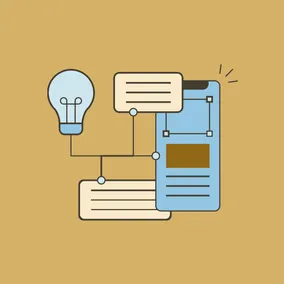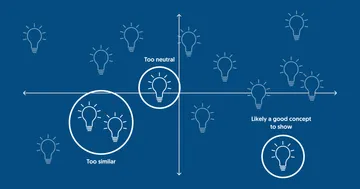The Keys to Successful Concept Testing: Prototyping

You and your team have new ideas, but will they resonate with your users? Concept testing helps you answer this question, and prototypes are key to bringing them to life!
This is part two of a three-part series on how to successfully conduct concept testing with users, focused on prototyping. Check out part one (planning) to learn more.
Prototype your concepts
Once a well-aligned research plan has been crafted, it’s time to create a prototype (or multiple) based on your concept. There are a plethora of ways you can create prototypes that communicate your concepts to users; I’ll cover strategies that will help spark meaningful reactions and conversation.
Provide context to ground your concept
We humans as a whole are poor predictors of our own future behaviors, so it’s really important that your concept testing simulates the future experience you’re trying to test. Ideally, you want to ground your concepts, so a participant can envision it in their own day-to-day. One of the best ways to do this is by building in context, whether into the prototype itself or in the way you actually test out the concepts.
You can ground a participant in what they would actually do by:
- Adding small contextual details into the prototype (e.g. the participant’s name or location).
- Providing the participant with a realistic scenario to frame the prototypes
- Designing a certain scenario into the actual prototype (e.g. error messages appear in).
- Conducting the test in the actual or simulated environment where it will be used.
Grounding a participant can make a difference in how someone interacts with your prototype. Let’s imagine you and your team are redesigning a part of an online food delivery platform for restaurants, specifically the parts that hosts and cashiers use. When you put your concept to the test, you can ground participants by “simulating” a lunch rush atmosphere (distractions, loud noises, etc).
Build real-ish prototypes
It might sound counterintuitive but you don’t need high-fidelity prototypes for concept testing. While high-fidelity prototypes may best simulate the future experience, that level of fidelity may not be feasible for a few reasons:
- You don’t have the time to create something at that level of detail or complexity before testing.
- You don’t have the details fleshed out yet.
- You want your users to help define these details with you.

Low to mid-fidelity (or as I like to call “real-ish”) prototypes can still get you to the insights you need and even have some unexpected benefits. It’s easier for research participants to focus on overarching concepts when interacting with low-fidelity prototypes. Higher fidelity prototypes tend to invoke feedback hyper-focused on the details. With lower-fidelity, research participants are more likely to provide critical feedback on ideas, since they don’t seem as “final.” You can also leave out certain details in a low-fidelity concept, which allows you to brainstorm with participants.
Again, crafting context is a large part of building out an idea that starts to feel “real” enough for a user to invoke a response. Some examples of real-ish prototypes with just enough context include:
- Setting the stage with realistic scenarios for how and when research participants would reach out to an AI chat bot in a therapy app.
- Creating initial wireframes for a ride-sharing app that research participants test out in a simulated car ride experience, to understand what info is most helpful at each moment on the ride.
- Sending research participants “updates” on their food delivery order, to learn what participants might want to know about their order’s progress.
Be selective about which concepts to show
You may have several concepts (or variations on a single concept) that you want to prototype out, and test through research. They may all feel exciting and important, but showing too many in one session can leave a research participant with decision fatigue. Even if you need to test multiple concepts to move forward, you don’t want to show every single one you’ve come up with.
Instead, you’ll want to be selective. One way to help you decide which concepts are best to test is by mapping them out on a matrix.

Let’s imagine again you and your team have generated multiple concepts for your food delivery app that aim to tempt users to order takeout more frequently. Perhaps some concepts focus on individualized recommendations, while other concepts show social trends. First, create a matrix that has extreme aspects of the concepts on each end and place them where you think they might belong.
Then, ask yourself a few questions:
- Are there two concepts that are too similar to each other?
- Is this concept playing it too safe?
These kinds of concepts may not give you useful feedback because they’re not distinct enough or they’re too neutral over all. Instead, you’ll want to select concepts that are on the edges of your extremes. Those concepts will allow you to learn much more about your users and how they might interact with your concepts in the future.
These tips will help you craft prototypes that research participants can more easily and accurately react to.
To end this series, I’ll discuss how to prepare for the actual testing in my next article.
